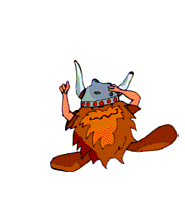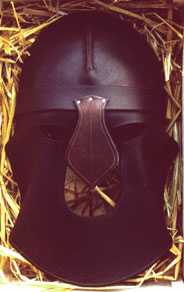

[Berserker|Berserkergang|Society]
The modern popular conception of the Viking warrior is one of a murderous savage, clad in animal skins, howling into battle.

[Berserker|Berserkergang|Society]
The etymology of the term *berserk* is disputed.
It may mean "*bare*-sark," as in "bare of shirt" and refer to the berserker's
habit of going unarmored into battle. Ynglingasaga
records this tradition, saying of the warriors of Odhinn that "they went
without coats of mail, and acted like mad dogs
and wolves". Others have contended that the term should be read
"*bear*-sark," and describes the animal-skin
garb of ther berserker.
The berserker is closely associated in many respects
with the god Odhinn. The name Odhinn derives from the Old Norse *odur*.
This is related to the German *wut*, "rage, fury," and to the Gothic *wods*,
"possessed" (Georges Dumezil. The Destiny of the Warrior.
This certainly brings to mind the madness associated
with the berserker, and other Odhinnic qualities are seen to be possessed
by the berserk. Ynglingasaga recounts that Odhinn could shape-shift into
the form of a bird, fish, or wild animal .
The berserker, too, was often said to change
into bestial form, or at least
to assume the ferocious qualities of the wolf
or bear.
|
Dumezil refers to this phenomenon as the *hamingja* ("spirit" or "soul")
or *fylgja* ("spirit form") of the berserker, which may
appear in animal form in dreams or in visions, as well as in reality
Another Odhinnic quality possessed by the berserk is a magical immunity
to weapons. In Havamal, Odhinn speaks of spells
used to induce this immunity:
|
A third song I know, if sore
need should come
Lee M. Hollander
|
The berserk was sometimes inherently possessed of this immunity, or
performed spells to induce it, or even had special powers to blunt weapons
by his gaze. Many tales say of their berserkers, "no weapon could bite
them" or "iron could not bite into him." This immunity to weapons may also
have been connected with the animal-skin garments worn by the berserk.
As we saw above, while in animal form, "blades and weapons glanced off"
Bodvar Bjarki. Similarly, Vatnsdoela Saga says that "those ebrserks who
were called *ulfhednar* had wolf shirts for mail-coats"
This concept of immunity may have evolved from the berserker's rage,
during which the berserk might receive wounds, but due to his state of
frenzy take no note of them until the madness passed from him. A warrior
who continued fighting while bearing mortal wounds would surely have been
a terrifying opponent.
It is likely that the berserk was actually a member of the cult of Odhinn.
The practices of such a cult would have been a secret
of the group's initiates, although the Byzantine emperor Constantine
VII refers in his Book of Ceremonies to a "Gothic Dance"
performed by members of his Varangian guard, who took part wearing
animal skins and masks. This type of costumed dance is also seen in figures
from Swedish helmet plates and scabbard ornaments, which depict human figures
with the heads of bears or wolves, dressed in animal skins but having human
hands and feet. These figures often carry spears or swords, and are depicted
as running or dancing. One plate from Torslunda, Sweden, may show the figure
of Odhinn dancing with such a bear figure.
Other ritual practices attributed to berserks may represent the initiation
of the young warrior into a band of berserkers. Such
bands are mentioned in the sagas, oftentimes numbering twelve warriors.
Another commin feature of these bands is the name of
the leaser, which is often "Bjorn" or a variant, meaning 'bear." The
form of this initiation is a battle, either real or simulated, with
a bear or other fearsome adversary. Grettirs Saga tells of a situation
of this sort, when a man named Bjorn throws Grettir's
cloak into the den of a bear. Grettir slays the bear, recovers his
claok, and returns with the bear's paw as a token of his victory Bodvar
Bjarki has a protege, Hjalti, who undergoes a simulated encounter as his
initiation in
Hrolf's Saga. Bodvar first slays a dragon-like beast, then sets its
skin up on a frame. Hjalti then "attacks" the beast and
symbolically kills it before witnesses, earning his place among the
warriors .
Bronze helmet plates from locations in Sweden and designs upon the
Sutton Hoo pyrse lid seem to show examples of these initiatory encounters,
where a human figure is seen grappling with one, or often two, bear-like
animals .
The Modern scholars believe that certain examples of berserker rage to have been induced coluntarily by the consumption of drugs such as the hallucinogenic mushroom *Amanita muscaria* , or massive quantities of alcohol
While such practices would fit in with ritual usages, other explanations
for the berserker's
madness have been put forward, including self-induced hysteria, epilepsy,
mental illness or genetic flaws
The physical appearance of the berserk was one calculated to present
an image of terror. Dumezil draws parallels between the
berserk and the tribe of Harii mentioned in Tacitus's Germania who
used not only "natural ferocity" but also dyed their bodues
to cause panic and terror in their enemies, just as the berserk combined
his fearsome reputation with animal skin dress to
suggest the terrifying metamorphosis of the shape changer .
Indeed, berserkers had much in common with those thought to be werewolves.
Ulf, a retired berserker, is mentioned in this light in Egils saga Skallagrimsonar:
|
But every day, as it drew towards evening, he would grow so ill-tempered that no-one could speak to him, and it wasn't long before he would go to bed. There was talk about his being a shape-changer, and people called him Kveld-Ulf. ["Evening Wolf"] Egil's Saga
|
In the sagas, berserks are often described as being fantastically ugly,
often being mistaken for trolls, as were Skallagrim and his
kinsmen in Egils saga Skallagrimsonar. Egil himself is described as
being "black-haired and as ugly as his father" , and at a feast in the
court of the English king Athelstan, Egil is said to have made such terrible
faces that Athelstan was forced to give him a gold ring to make him stop:
|
His eyes were black and his eyebrows joined in the middle. He refused to touch a drink even though people were serving him, and did nothing but pull his eyebrows up and down, now this one, now the other.. Ibid.
|
Berserkergang
The actual fit or madness the berserk experienced was known as *berserkergang*.
This condition is described as follows:
|
This fury, which was called
berserkergang, occurred not only
Fabing |
|
*To gain this bear-like strength, the berserk might
drink the blood of
Straight away bring your
throat to its steaming blood and devour
(Saxo)
* The aftermath of the berserkergang was characterized
by complete
|
Egils saga Skallagrimssonar says:
What peoplke say about shape-changers or those who go into berserk fits is this: that as long as they're in the frenzy they're so strong that nothing is too much for them, but as soon as they're out of it they become much weaker than normal. That's how it was with Kveldulf; as soon as the frenzy left him he felt so worn out by the battle he'd been fighting, and grew so weak as a result of it all that he had to take to his bed.
A common technique used by saga heroes to overcome berserks was to catch
them after their madness had left them, as
Hjalmar and Arrow-Odd do in Herverar Saga, and slay the berserkers
while they lay in their enfeebled state after their fury
(Christopher Tolkein The Saga of King Heidrek the Wise.)
The Role of the Berserker in Viking Society
The berserker's place in society was limited by the terror and violence
that was associated with berserkergang. As superb
warriors, they were due admiration. However, their tendency to turn
indicriminately upon their friends while the madness was
upon them went squarely against the heroic ethic, which demanded loyalty
and fidelity to one's friends. The berserk skirted the
classification of *ni(dh)ingr*, one who was the lowest of men and the
object of hate and scorn.
An eleventh-century monument raised in Soderby in Uppland, Sweden in memory of a
brother reads:
|
And Sassur
killed him and
-- he betrayed
his comrade
|
The primary role of the berserk was as a warrior attacked to a king's
army. Both King Harald and King Halfdan had berserker
shock-troops. Aside from their military value, the berserker's ties
to Odhinn would have been welcome in a royal army, since
Odhinn also had a particular association with rulership, being venerated
in Anglo-Saxon England as the ancestor of chieftains,
and throughout the North as god of kings and protector of their royal
power.
Outside of this role, however, the berserker became the stock villain
of the sagas, typified as murderous, stupid brutes, or as
one modern critic has it, "a predatory group of brawlers and killers
who disrupted the peace of the Viking community
repeatedly" .
Saxo Grammaticus speaks of such a band in his Gesta Danorum:
In addition to their warlike activities within their communities, berserkers are characterized by their sexual excesses, carrying off wves, daughters and betrothed maids who then must be rescued by the heroes of the sagas. Saxo was particularly upset by this behavior:The young warriors would harry and pillage the neighborhood,
and frequently spilt great quantities of blood. They considered
it manly and proper to devastate homes, cut down cattle, rifle
everything and take away vast hauls of booty, burn to the ground
houses they had sacked, and butcher men and women
indicriminately"
So outrageous and unrestrained were their ways that they
ravished other men's wives and daughters; they seemed to
have outlawed chastity and driven it to the brothel. Nor did
they stop at married women but also debauched the beds
of virgins. No man's bridal-chamber was safe; scarcely
any place in the land was free from the imprints of their lust"
It was no doubt due to these excesses of the berserker that resulted
in their demise. In 1015 King Erik outlawed berserks, along with *holmganga*
or duels.
It had become a common practice for a berserker to challenge men of
property to holmgang, and upon slaying the unfortunate victim, to take
possession of his goods, wealth, and women. This was a difficult tactic
to counter, since a man so challenged had to appear, have a champion fight
for him, or else be named *ni(dh)ingr* and coward.
In 1123, the Icelandic Christian Law stated, "If someone goes berserk,
he is punished with lesser outlawry and the men who are
present are also banished if they do not bind him." Lesser outlawry
(*fjorbaugsgard*) was a sentence of three years' banishment
from the country.
 |
Leathermask, Raven